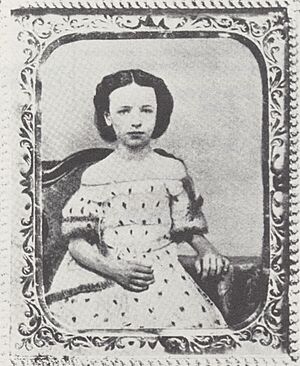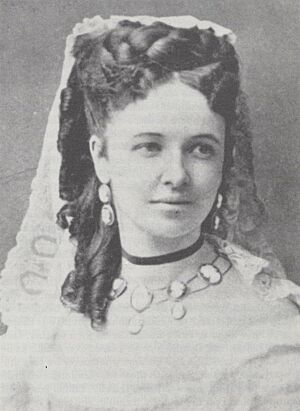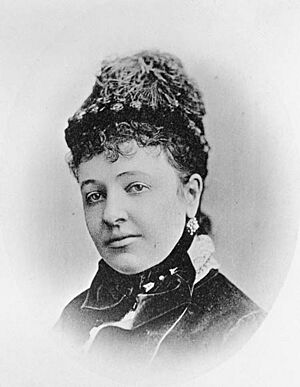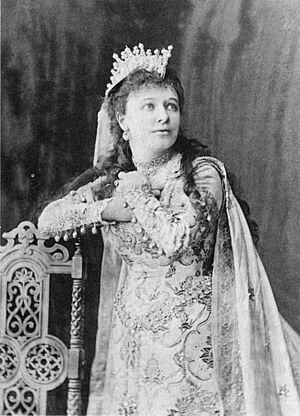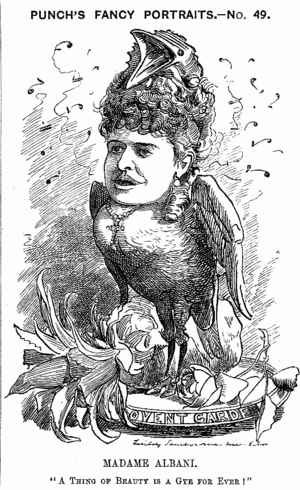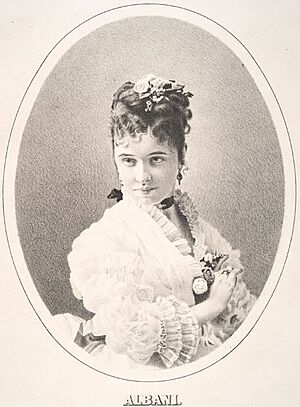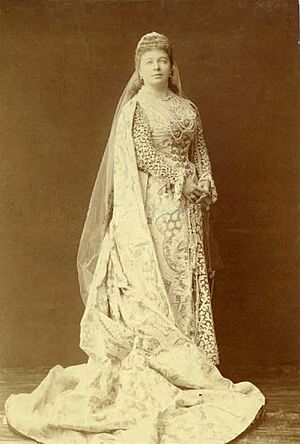Emma Albani facts for kids
Quick facts for kids
Emma Albani
|
|
|---|---|
 |
|
| Born |
Marie-Louise-Emma-Cécile Lajeunesse
1 November 1847 Chambly, United Province of Canada (present-day Chambly, Quebec)
|
| Died | 3 April 1930 (aged 82) Kensington, England
|
| Occupation | Operatic coloratura soprano, spinto soprano, dramatic soprano |
| Spouse(s) |
Ernest Gye
(m. 1878; |
| Children | 1 |
| Signature | |
Dame Emma Albani (born Marie-Louise-Emma-Cécile Lajeunesse; November 1, 1847 – April 3, 1930) was a famous Canadian-British opera singer. She was a soprano, which means she had a high singing voice. Emma Albani was the first Canadian singer to become a huge international star. She sang in operas by famous composers like Mozart, Rossini, and Wagner. Her amazing voice took her all over Europe and North America.
Contents
Early Life and Musical Start
Emma Albani was born Marie-Louise-Emma-Cécile Lajeunesse in Chambly, Quebec. Her parents, Joseph and Mélina, were French-Canadians. Her father was a professional musician who played the violin, harp, piano, and organ. Emma started learning music from her mother, and by age five, her father took over her lessons. He made sure she practiced a lot, sometimes up to four hours a day on the harp and piano!
The family moved to Plattsburgh, New York, in 1852. After her mother passed away in 1856, Emma continued her education at a convent school in Montreal. This school gave her a great education and more music lessons. She even won a gold medal for composing music there.
Moving to Study Music
It was hard for Emma to get a full music education in Quebec because singing and acting were not seen as good careers for women back then. So, her family moved to Albany, New York in 1865. Her father couldn't give her all the training her beautiful voice needed. But Emma joined the cathedral choir, where her singing got a lot of attention. She also sang and played piano and harp in concerts. She saved enough money to continue her studies.
In 1868, Emma traveled to Paris, France, to study with a teacher named Gilbert Duprez. After six months, she went to Italy to learn Italian opera singing from Francesco Lamperti. Her speech teacher, Signor Delorenzi, suggested she change her name to something simpler and more European. That's how Marie-Louise-Emma-Cécile Lajeunesse became Emma Albani. She made her first opera performance in Messina, Italy, using her new name.
Becoming an Opera Star
Emma's money started to run out, so she looked for work to help pay for her lessons. She found a job in Messina, Italy. Her first opera performance was on March 30, 1870. She played the role of Amina in an opera called La sonnambula. Her debut was a huge success! She later remembered being "loaded with flowers, presents, and poetry." People even sent a live dove painted red flying around the theater!
After her contract in Messina ended, she went back to Milan to continue studying with Lamperti. Soon, many offers for roles came in. She sang in operas like Rigoletto, Lucia di Lammermoor, and The Barber of Seville. After performing in Malta, she auditioned for Frederick Gye, the manager of the Covent Garden in London. He was very impressed and signed her to a five-year contract.
Singing in London
Emma Albani arrived in London in the spring of 1872. Her first performance there was on April 2, 1872, again as Amina in La sonnambula. Critics and the audience loved her strong performance. Her fans gave her flowers and jewelry. At Covent Garden, she became interested in oratorio, which is a large musical piece for voices and orchestra, usually based on a religious story.
In her second season in London, she sang as Ophelia in Hamlet and the Countess in The Marriage of Figaro. During her time off, she traveled to Moscow and St. Petersburg to perform. Even the Tsar Alexander II watched her sing!
In her third season in London, Queen Victoria asked Emma to perform for her privately. Emma went to Windsor Castle in July 1874. She sang famous songs and arias. The Queen was very impressed and often asked Emma to perform for her again.
Touring North America
In the fall of 1874, Emma went on a tour of the United States. She visited big cities like New York, Boston, Philadelphia, and Chicago. She even learned a new role, Elsa in Wagner's Lohengrin, in just two weeks! She sang it at the Academy of Music in New York.
She returned to London for her fourth season at Covent Garden in 1875. In her fifth season (1876), she performed as Elisabeth in the London premiere of Wagner's Tannhäuser. After this, she sang in Paris and even performed for the French President.
Marriage and Family
Emma Albani married Ernest Gye on August 6, 1878. She became pregnant but kept touring and performing until just before her son, Frederick Ernest Gye, was born on June 4, 1879. He was their only child.
Throughout the 1880s, Emma toured Europe and North America, receiving praise everywhere. In 1881, she was invited to sing in Lohengrin at the Berlin Royal Opera. She had sung the role in Italian before, but she learned it in German for this performance. The German Emperor, Kaiser Wilhelm I, attended, and the audience loved it, calling her back for three curtain calls. In 1882, the Kaiser gave her the special title of Hofkammersängerin.
In 1883, she gave three concerts in Montreal, Canada. More than ten thousand people came to greet her when she arrived! Her first opera performance in Canada was on February 13, 1883, in Toronto, where she sang in Lucia di Lammermoor.
Singing in New York
Emma Albani made her debut with New York's Metropolitan Opera on November 20, 1891. She sang as Valentine in Les Huguenots. She also sang as Desdemona in the company's first performance of Verdi's Otello. Other roles she performed with the Met included Gilda in Rigoletto and Elsa in Lohengrin. Her first performance with the company in New York City was as Gilda on December 23.
She performed many times with the Met, singing roles like Donna Elvira in Don Giovanni and Eva in Die Meistersinger von Nürnberg. Her last performance with the Met was on March 31, 1892, as Senta in The Flying Dutchman. All the operas she sang in were performed in Italian.
Even in her final season at Covent Garden in 1896, Emma Albani received great reviews. The biggest success of her career came on June 26, 1896, when she sang Isolde in Wagner's Tristan und Isolde. All four performances sold out, even though tickets were more expensive than usual and the opera was sung in German. On July 24, she sang Valentine in Les Huguenots. This was her last opera performance at Covent Garden, ending a career there that had lasted twenty-four years.
Later Years and Legacy
After leaving Covent Garden in 1896, Emma toured Canada and then Australia in 1898. She also continued to perform oratorios in Britain. She gave her farewell concert at the Albert Hall in London in 1900.
In 1907, Emma toured Australia and New Zealand again. In 1908, she toured England with two rising talents: pianist Marie Novello and tenor John McCormack. Emma Albani gave her very last public performance on October 14, 1911. That same year, she released a book called Forty Years of Song. It was her memoir, sharing stories from her youth, travels, and career. She also wrote about the other performers and royalty she met.
Emma and her husband retired to Kensington, England. Unfortunately, they lost a lot of their money due to bad investments. Emma had to give music lessons to earn income. Her husband passed away in 1925, making things harder. But friends organized special concerts to help her, which provided enough money. Emma Albani died on April 3, 1930, at age 82. She was buried with her husband at Brompton Cemetery.
Honors and Remembering Emma Albani
Emma Albani received the gold medal from the Royal Philharmonic Society in 1897. This medal is sometimes called the "Beethoven Medal."
The character of Madame Selitsky in Lucy Maud Montgomery's famous book Anne of Green Gables (1908) was inspired by Emma Albani. Montgomery later wrote about Emma in her book Courageous Women (1934). In 1925, Emma Albani was made a Dame Commander of the Order of the British Empire. This is a very high honor from the British Crown.
The Historic Sites and Monuments Board of Canada placed a plaque at her birthplace in 1939, which was replaced with a stone monument in 1977.
Several streets and places in Quebec have been named after her. Two streets in Montreal are named in her honor. In 1980, Canada Post released a postage stamp honoring her on the 50th anniversary of her death. The stamp shows her in costume as Violetta from the opera La Traviata.
In the 1990s, the former mayor of Chambly, Robert Lebel, started the Emma Albani fund for musical arts in the town. Emma Albani is also shown in a beautiful stained-glass mural by Frédéric Back at the Place-des-Arts metro station in Montreal.
Images for kids


